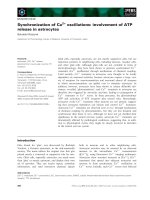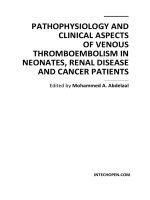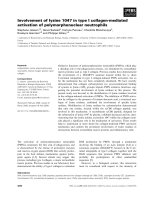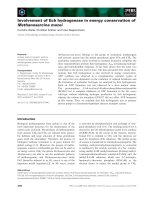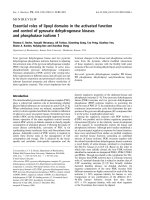Involvement of nm23 m2 in dopaminergic neuronal differentiation and cell cycle arrest
Bạn đang xem bản rút gọn của tài liệu. Xem và tải ngay bản đầy đủ của tài liệu tại đây (1.58 MB, 150 trang )
INVOLVEMENT OF NM23-M2 IN DOPAMINERGIC
NEURONAL DIFFERENTIATION AND CELL CYCLE
ARREST
LOH CHIN CHIEH
NATIONAL UNIVERSITY OF SINGAPORE
2006
INVOLVEMENT OF NM23-M2 IN DOPAMINERGIC
NEURONAL DIFFERENTIATION AND CELL CYCLE
ARREST
LOH CHIN CHIEH
(B. Appl. Sci. (2nd Upper Hons.), NUS)
A THESIS SUBMITTED
FOR THE DEGREE OF MASTER OF SCIENCE
DEPARTMENT OF BIOLOGICAL SCIENCES
NATIONAL UNIVERSITY OF SINGAPORE
2006
Acknowledgements
This present thesis work has been arduous yet enriching and rewarding experience
for me. I would like to acknowledge all those who have been a part of this experience
without whom I could not have completed the undertaken task.
Firstly I would like to thank my research advisor, Associate Professor Lim Tit
Meng, Vice Dean of Science Faculty, NUS and principal investigator of Developmental
Biology Laboratory (DBL) in Department of Biological Sciences, to whom I am greatly
indebted for professional guidance and encouragement throughout my graduate studies. I
am very fortunate to have him as a considerate advisor and deeply appreciative of him for
giving me this opportunity to be involved in his ongoing research.
I would also like to thank Mr. Yan Tie, our laboratory manager for his excellent
technical support and valuable advices, hence making it possible for me to carry out my
bench-work with ease.
I will also cherish the memorable time that I spent working in this laboratory.
Special thanks to my mentor, Ms. Christina Teh Hui Leng for giving me continual
guidance and help; to my fellow colleagues, Mr. Kevin Lam Koi Yau, Mr. Rikki Tay
Kian Ghee, for lending a listening ear to my thoughts; and to all colleagues working in
the DBL for their sincere help and technical support in one way or another.
Last but not least, I would like to thank my loved ones, my parents and my sister
for their love and understanding. Special heartfelt thanks to my future wife, Ms. Lee Hui
Cheng for showering me with love and continual support especially during this period.
i
Contents
Acknowledgements
i
Contents
ii
Summary
vii
List of figures
ix
List of tables
xi
List of abbreviations
xii
Chapter 1: Introduction
1
1.1
Prevalence of Parkinson’s Disease in Singapore
2
1.2
Parkinson’s Disease
2
1.3
Dopaminergic neurons
3
1.4
Therapies used in treatment of Parkinson’s disease
4
1.4.1
6
Neuroprotection by neurotrophic factor interventions
1.4.2 Gene transfer therapy
6
1.4.3
Xenogeneic transplantation therapy
8
1.4.4
Cell replacement therapy
8
1.4.5
Deep brain stimulation therapy
9
1.5
Neural stem cell and MN9D hybrid cell line
10
1.6
Differentiation of neural stem cells (NSC)
12
1.6.1 Intracellular factors that cause differentiation of NSC
12
into dopaminergic neurons
1.6.2
Extracellular factors that cause differentiation of NSC
15
into dopaminergic neurons
1.7
Significance of genes involved in dopaminergic neuron differentiation
16
1.8
Literature reviews on factors that cause neurite outgrowth and
17
ii
differentiation in MN9D
1.9
The nm23 gene family
18
1.9.1
Biochemical functions of nm23/NDPK proteins
19
1.9.2
Cellular studies support a role for nm23/NDPK in signal
22
transduction
1.9.3
Nm23/NDPK homologues in fruit fly development and
23
differentiation
1.9.4
Nm23/NDPK in hematopoietic differentiation
24
1.9.5
Nm23/NDPK in mammalian neuronal cell development
25
and differentiation
1.9.6 Role of nm23/NDPK in neuroblastoma differentiation
27
Objective of this study
28
Chapter 2: Materials and methods
30
2.1
Routine cell culture of MN9D and SH-SY5Y cell lines
31
2.2
Cloning of full length nm23-M2 gene
32
2.2.1 Total RNA isolation
32
2.2.2
34
1.10
Reverse Transcriptase-PCR (RT-PCR) of full length
nm23-M2 gene
2.2.3 Gel extraction and DNA purification of nm23-M2
34
2.2.4
35
Cloning of full length nm23-M2 coding sequence
into pGEM-T EasyTM plasmid vector
2.2.5
Transformation of recombinant plasmids into bacterial
36
competent cells
2.2.5.1 Preparation of bacterial competent cells
36
2.2.5.2 Transformation
36
iii
2.2.6
Colony PCR screening for positive clones
37
2.2.7
Plasmid DNA isolation from positive clones
38
2.2.8
Cloning of full length nm23-M2 coding sequence into
39
mammalian pcDNA3.1-GFP and pcDNA 3.1-MYC plasmid
vector
2.2.9 Cycle sequencing
40
2.2.10 Ethanol/sodium acetate precipitation for DNA purification
41
2.2.11 Capillary electrophoresis sequencing on ABI PRISM 3100
41
Genetic Analyzer
2.2.12 DNA gel electrophoresis
42
2.3
Construction of cDNAs for Real-time PCR
42
2.4
Real-time PCR
43
2.5
Transfection of plasmid construct to mammalian cells
44
2.6
Protein work
44
2.6.1
Isolation of total cell lysate
44
2.6.2
Bio-Rad Bradford protein quantification assay
45
2.6.3
Protein separation using sodium dodecyl sulphate-
45
polyacrylamide electrophoresis (SDS-PAGE)
2.6.4
Western immunoblot analysis
46
2.7
Subcellular fractionation
48
2.8
Fluorescence microscopy and neurite assay
48
2.9
Flow cytometry
49
2.10
siRNA interference
50
iv
Chapter 3: Results
56
3.1
Cloning and characterization of full-length nm23-M2 cDNA
57
3.1.1
57
Cloning of full-length pcDNA3.1(-)_
fl nm23-M2_GFP and pcDNA3.1(-)_fl nm23-M2_MYC
3.1.2
Routine tissue culture
61
3.1.3
Temporal expression of nm23-M2 during MN9D
64
cell differentiation
3.2
3.1.4
Spatial expression of nm23-M2 in MN9D and SH-SY5Y cells
66
3.1.5
Subcellular localization of nm23-M2
68
Overexpression studies of nm23-M2 in MN9D cells
70
3.2.1
70
Morphological appearance of MN9D overexpressing
pcDNA3.1(-)_fl nm23-M2_GFP
3.2.2
MN9D cells showed cell growth arrest when treated with
72
n-butyric acid and transfected with nm23-M2
3.2.3
SNAP-25 protein expression was up-regulated in MN9D
74
cells overexpressing pcDNA3.1(-)_fl nm23-M2_GFP
3.2.4
Cyclin D1 mRNA and protein expression was down-regulated
76
in MN9D cells overexpressing pcDNA3.1(-)_fl nm23-M2_GFP
3.3
SiRNA interference studies of nm23-M2 in MN9D cells
78
3.3.1
Knockdown expression of nm23-M2 mRNA upon siRNA
interference
78
3.3.2
Morphological appearance of MN9D cells after transient
79
siRNA knockdown of nm23-M2
3.3.3
Cell cycle analysis of n-butyric acid-treated MN9D cells when
81
nm23-M2 siRNA was added
3.3.4
SNAP-25 protein level of n-butyric acid-treated MN9D cells
82
v
did not increase when nm23-M2 siRNA was added
3.3.5
Cyclin D1 protein level of n-butyric acid-treated MN9D cells
83
did not decrease when nm23-M2 siRNA was added
Chapter 4: Discussion
84
4.1
Choice of cell line model
85
4.2
Temporal and spatial expression of nm23-M2 gene
85
4.3
The role of nm23-M2 in dopaminergic MN9D differentiation
87
4.4
The role of nm23-M2 in inducing cell cycle arrest
89
4.5
Further studies to elucidate the differentiation pathway
92
4.6
Future experiments
94
4.7
Conclusion
95
References
97
vi
Summary
Nm23 genes which encode nucleoside diphosphate kinases (NDPKs) are
ubiquitous metabolic enzymes, responsible for the synthesis of nonadenine nucleoside
triphosphates from the corresponding diphosphates, with ATP as phosphoryl donor. In the
brain, nm23/NDPK have been implicated to modulate neuronal cell proliferation,
differentiation, and neurite outgrowth. The nm23-M2 gene is the focus of this thesis
because this gene was found to be up-regulated during n-butyric acid induced MN9D
differentiation through subtractive library screening and micro-array analysis. Reviews of
relevant literature also supported its involvement in cell development and differentiation.
Moreover, overexpression of nm23 genes induces neuritogenesis and stimulates the
differentiation pathways in many cell lineages.
In order to determine what role, if any, nm23-M2 gene might play in
dopaminergic neuronal differentiation, this study made use of a catecholamine producing
hybrid dopaminergic cell line, MN9D as an in vitro cell model system for overexpression
and siRNA interference experimentation. The temporal expression was studied during nbutyric acid induced MN9D differentiation by measuring the endogenous level of nm23M2 mRNA by semi-quantitative real-time PCR. GFP reporter system was also used to
analyze the spatial expression pattern of nm23-M2-GFP protein in MN9D and SH-SY5Y
cell lines using fluorescent microscopy techniques. It was demonstrated for the first time
that overexpression of nm23-M2 itself in MN9D cell line resulted in significant increase
in the number of cells bearing neurites and an alteration of the cell cycle, increased G1phase. Analysis of immunoblots revealed that this morphological differentiation was
accompanied by an increased expression of a neuronal maturation marker, synaptosomal
protein SNAP-25 and decreased expression of a G1 stage cell cycle marker, cyclin D1.
The n-butyric acid-induced neurite outgrowth in MN9D cells was also abolished by
vii
nm23-M2 siRNA treatment although the level of SNAP-25 and cyclin D1 remained
unaltered by siRNA interference. Therefore, it is plausible that nm23-M2 gene 1)
regulates neurite outgrowth in dopaminergic MN9D cells acting via the modulation of
SNAP-25 gene expression, and 2) represses transcription of positive regulators, cyclin D1
of cell cycle, to initiate cell cycle arrest.
These data support the hypothesis that nm23-M2 plays a role in dopaminergic
neuronal differentiation through initiating neurite outgrowth and inducing growth arrest.
The findings and proposed future work may eventually contribute to the understanding of
pathways or mechanisms on the induction of dopaminergic neuron differentiation that
could facilitate the development of gene delivery or cell replacement therapeutics for
brain neurodegenerative disorders.
viii
List of figures
Figure 2.1
Plasmid map and sequence reference points of pGEM-T
52
Easy cloning vector
Figure 2.2
Plasmid map and sequence reference points of pcDNA3.1(+/-)
53
cloning vector
Figure 3.1
Total RNA isolation
59
Figure 3.2
NM_008705 nm23-M2 mRNA
59
Figure 3.3
RT-PCR amplification of full-length nm23-M2 cDNA
59
Figure 3.4
Restriction enzyme digestion of pGEM-T Easy_mNm23-M2
60
recombinant plasmid
Figure 3.5
Restriction enzyme digestion of pcDNA3.1(-)_mNm23-M2
60
recombinant plasmid
Figure 3.6
MN9D time-course differentiation
63
Figure 3.7
Model of a single amplification plot used in real-time PCR
64
Figure 3.8
A graph showing multiple amplification plots during the
65
real-time PCR run
Figure 3.9
A graphical representation showing changes in endogenous
65
mRNA level of nm23-M2 post-induction of MN9D cells with
1mM n-butyric acid
Figure 3.10
Spatial expression of nm23-M2 in MN9D and SH-SY5Y cells
67
Figure 3.11
Western immunoblot analysis of GFP in transfected MN9D cells
68
Figure 3.12
Western immunoblot analysis of Oct-1 and C-Myc
69
Figure 3.13
Morphology of transfected MN9D cells
71
Figure 3.14
A graph showing the morphological changes of MN9D cells
72
after 2 days post-transfection of nm23-M2
ix
Figure 3.15
A table showing the percentage of MN9D cells at different stages 73
of the cell cycle in different conditions
Figure 3.16
A graph showing the percentage of MN9D cells after 2 days
73
post-transfection of GFP null plasmid and nm23-M2 plasmid
Figure 3.17
Western immunoblots showing overexpression results after 48hr
75
of transfection using mouse anti-SNAP-25 monoclonal antibody
Figure 3.18
Western immunoblots using mouse anti-cyclin D1 monoclonal
77
antibody and RT-PCR of cyclin D1 showing overexpression
results after 48hr of transfection
Figure 3.19
RT-PCR of nm23-M2 after siRNA interference
78
Figure 3.20
A graph showing the morphological changes of MN9D cells
80
after 24hr post-transfection of control siRNA and nm23-M2
siRNA
Figure 3.21
A graph showing the percentage of MN9D cells after 48hr post-
81
transfection of control and nm23-M2 siRNA
Figure 3.22
Western immunoblots showing siRNA interference results
82
after 24hr of transfection using mouse anti-SNAP-25
monoclonal antibody
Figure 3.23
Western immunoblots showing siRNA interference results
83
after 24hr of transfection using mouse anti-Cyclin D1
monoclonal antibody
Figure 4.1
A schematic representation of cell cycle progression showing
90
cyclins function as regulators of CDK kinases
Figure 4.2
A schematic representation showing positive and negative
91
regulators in the cell cycle progression
x
List of tables
Table 2.1
Preparation of SDS-PAGE gel with the listed required
54
components
Table 2.2
Primary and secondary antibodies application for western
55
blotting in this thesis
xi
List of abbreviations
6-OHDA
6-hydroxydopamine
A260
Absorbance at 260 nm
AMP, ADP, ATP
Adenosine 5’-mono-, di-, or triphosphate
APS
Ammonium persulphate
awd
Abnormal wing discs
BDNF
Brain-derived neurotrophic factor
bFGF
basic fibroblast growth factor
bp
Base pair
BSA
Bovine serum albumin
CKI
CDK inhibitors
CDKs
Cyclin-dependent kinases
cDNA
Complementary DNA
CO2
Carbon dioxide
CTP
Cytidine 5’ triphosphate
DA
Dopamine
DBS
Deep brain stimulation
DDS
Dopamine dysregulation syndrome
DMEM
Dubecco’s Modified Eagle’s Medium
DNA
Deoxyribonucleic acid
dNTP
Deoxynucleoside 5’ triphosphate
DTT
Dithiothreitol
EDTA
Ethylenediaminetetraacetate
EGF
Epidermal growth factor
xii
ETBR
Ethidium Bromide
EtOH
Ethanol
FACS
Fluorescence Activated Cell Sorting
Fgf8
Fibroblast growth factor 8
g (eg. 5,000 x g)
Gravity
GDNF
Glial cell line-derived neurotrophic factor
GFP
Green fluorescent protein
GTP
Guanosine 5’ triphosphate
HPRT
Hypoxanthine-Guanine Phosphoribosyl Transferase
Hr
Hour
HRP
Horse radish peroxidase
IPTG
Isopropyl-ß-D-thiogalactopyranoside
JNK
c-Jun N-terminal kinase
k-pn
Killer of prune
kB
Kilobase
kD
Kilodalton
LB
Luria-Bertani
LBs
Lewy bodies
L-Dopa
Levadopa
M
Molar
MAPK
Mitogen-activated protein kinase
MgCl2
Magnesium chloride
mg
Milligram
Min
Minute
ml
Milliliter
xiii
mM
Millimolar
MPP+
N-methyl-4-phenylpyridinium ion
MPTP
N-methyl-4-phenyl-1,2,3,6-tetrahydropyridine
mRNA
Messenger RNA
NaCl
Sodium chloride
NADH
Nicotinamide adenine dinucleotide
NaOAc
Sodium acetate
ng
Nanogram
nm
Nanometer
NDPK
Nucleotide diphosphate kinase
NGF
Nerve growth factor
NHE
Nuclease hypersensitive element
NSC
Neural stem cell
NTF
Neurotrophic factor
NTN
Neurturin
OD
Optical density
PAGE
Polyacrylamide electrophoresis
PBS
Phosphate-buffered saline
PC12
Pheochromocytoma cell line
PCR
Polymerase chain reaction
PD
Parkinson’s disease
Rb
Retinoblastoma
RMT
Rostal mesencephalic tegmentum
RNA
Ribonucleic acid
RNase
Ribonuclease
xiv
ROS
Reactive oxygen species
rRNA
Ribosomal RNA
RT
Reverse transcriptase
RT-PCR
Reverse transcription-PCR
SDS
Sodium dedocyl sulfate
SHH
Sonic hedgehog
siRNA
Small interference RNA
SNAP-25
Synaptosomal-associated protein of 25 kDa
SNpc
Substantia nigra par compacta
STN
Subthalamic nucleus
TAE
Tris acetate
TBS
Tris buffer saline
TEMED
N, N, N, N-tetramethylethylene-diamine
TGF-β
Transforming growth factor-β
TH
Tyrosine hydroxylase
TPA
12-O-tetradecanoylphorbol-13-acetate
Tris
Tris(hydroxylmethyl)-aminomethane
Tris-HCl
Tris-hydrochloride
USA
United States of America
UTP
Uridine 5’ triphosphate
VM
Ventral mesencephalon
VTA
Ventral tegmental area
µg
Microgram
µl
Microliter
UV
Ultraviolet
xv
µm
Micrometer
%
Percent
o
Degree Celsius
C
xvi
Chapter 1: Introduction
Chapter 1:
Introduction
1
Chapter 1: Introduction
Chapter 1: Introduction
1.1
Prevalence of Parkinson’s Disease in Singapore
Parkinson Disease (PD) is the 2nd most common neurodegenerative
disorder after Alzheimer’s disease. Estimate of prevalence rates worldwide range
from 10 to 450 per 100,000 population (Zhang and Roman, 1993). Both genetic
and environmental agents have been implicated in PD (Tan et al. 2000; Allam et
al. 2005). A recent study in Singapore (Tan et al. 2004) showed that PD occurs as
commonly as in the West. 3 out of every thousand individuals, aged 50 years and
above, will have this disease. Prevalence of PD was also investigated between
Singapore Chinese, Malays and Indians and the environmental factors may be
more important than racially determined genetic factors in the development of PD.
As Singapore’s population continues to age, the number of people with PD is
expected to rise. Due to the increasing proportion of elderly individuals, PD
represents a growing burden on the health care system.
1.2
Parkinson’s Disease
In 1817, British physician and geologist James Parkinson gave the first
clear description of what is now known as PD in "An Essay on the Shaking
Palsy”. By observing people on the streets on London, he noticed that some had
tremors, or shaking palsy, that worsened over time. In this early stage of medical
science, physical tests and examinations of this disease were unheard of. Dr.
James Parkinson could not know the full range of symptoms that would eventually
be referred as PD. Through years of dedicated research, scientists searched further
for the causes and symptoms of PD. It is now known that PD is a
2
Chapter 1: Introduction
neurodegenerative disorder in which the most predominant neuropathological
feature is characterized by a progressive loss of the midbrain mesencephalic
dopaminergic neurons located in the substantia nigra pars compacta (SNpc) and
ventral tegmental area (VTA) that provides innervation to the striatum
(nigrostriatal system) and the cortex and limbic areas (mesocortical and
mesolimbic system), respectively. Clinically, most PD patients show signs of the
cardinal symptoms of bradykinesia, resting tremor, rigidity, and postural
instability (Bergman and Deuschl, 2002; Fahn, 2003). A number of patients also
suffer from autonomic, cognitive, and psychiatric disturbances. The pathological
hallmarks of PD are round eosinophilic intracytoplasmic proteinaceous inclusions
termed Lewy bodies (LBs) and dystrophic neuritis (Lewy neuritis) present in
surviving neurons (Forno, 1996).
1.3
Dopaminergic neurons
Dopaminergic neurons are an anatomically and functionally heterogeneous
group of cells, localized in the diencephalons, mesencephalon and the olfactory
bulb (Björklund & Lindvall, 1984). The most prominent dopaminergic cell group
resides in the ventral part of mesencephalon, which contains approximately 90%
of the total number of brain dopaminergic cells. The mesencephalic dopaminergic
system has been subdivided into the nigrostriatal, mesolimbic and mesocortical
system. The mesolimbic and mesocortical dopaminergic systems, which arise
from dopaminergic cells present in the ventral tegmental area (VTA). The cells of
the VTA in mesolimbic dopaminergic system project most prominently into the
nucleus accumbens, olfactory tubercle but also innervate the septum, amygdale
and hippocampus, whereas the cells in the medial VTA of the mesocortical
3
Chapter 1: Introduction
dopaminergic system project to the prefrontal, cingulated and perirhinal cortex.
Probably the best known is the nigrostriatal system which originates in the zona
compacta of the substantia nigra and extends its fibers into the caudate-putamen
(dorsal striatum). The identity of early proliferating dopaminergic progenitor cells
and development of the nigrostriatal dopaminergic neurons in the ventral
mesencephalon floor are specified by the existence of two secreted signaling
proteins, sonic hedgehog (Shh) (Hynes et al. 1995) and fibroblast growth factor 8
(Fgf8) (Ye et al. 1998), derived from the floor plate of the ventral midline and the
mid/hindbrain border, respectively. These neurons are the source of striatal
dopamine (DA), a major neurotransmitter that is responsible for motor functions.
The specific loss of dopaminergic neurons in the SNpc is a trait of PD and results
in severe motor disturbances and abnormalities, while alterations in dopaminergic
transmission from the VTA has been implicated in schizophrenia and drug
addiction. Due to the importance of these DA neurons in human pathology,
survival and induction of dopaminergic neurons has always been the subject of
intense study.
1.4
Therapies used in treatment of Parkinson’s disease
While there are multiple causes of this neurodegenerative disease
including environmental, genetic and age-associated factors, the treatments may
be targeted at similar underlying mechanisms via neuroprotective and reparative
intervention. Many data show that the selectively susceptible DA neurons in the
substantia nigra of the patients that have developed Parkinson’s disease can be
altered by protective and reparative therapies. Traditional oral drug administration
of levadopa (L-Dopa), the precursor of DA, initially was shown to improve life
4
Chapter 1: Introduction
expectancy and relieves parkinsonian motor signs during the first six years of
therapy (Dunnett and Bjorklund, 1999; Tan, 2001; Weiner 1982), but its
protective effectiveness was subsequently shown to decline and long term use is
associated with severe fluctuations in drug response (Agid et al. 1990; Curtis et al.
1984). Pramipexole, an antiparkinsonian agent which is neuroprotective against 1methyl-4-phenyl-1,2,3,6-tetrahydropyridine (MPTP)-induced damage to the DA
system in mice (Kitamura et al. 1997). This dopamine agonist has become an
efficient and safe drug for the treatment of Parkinson's disease recently (Bennett
and Piercey, 1999). However, particular caution has to be exercised in younger
Parkinson's disease patients with a shorter disease duration regarding the
occurrence of sudden onset of sleep (Moller and Oertel, 2005). Initial symptoms
in PD such as oxidative stress, protein abnormalities, and cellular inclusions could
be treated by antioxidants (Prasad et al. 1999; Shults, 2005) and trophic factors
(Grondin and Gash, 1998). If the delay of degeneration is not sufficient, then
immature dopamine neurons can be placed in the parkinsonian brain by
transplantation. Such neurons can be derived from stem cell sources or even
stimulated to repair from endogenous stem cells. Many new strategies are being
pursued in the development of new therapies for PD. These range from the use of
neurotrophic factors (Takayama et al. 1995), gene therapy or genetic manipulation
to increase the volume of dopamine production by increasing the number of
human tyrosine hydroxylase (TH) transcripts by employing viral vectors (ChoiLundberg et al. 1997), or transplantation of xenogeneic materials (Deacon et al.
1997), or transplantation of human fetal tissue (Olanow et al. 1996) to deep brain
stimulation (Diamond and Jankovic, 2005; Olanow et al. 2000). The search for
candidate molecules that promote the regeneration and survival capacities of DA
5
Chapter 1: Introduction
neurons is a major area of investigation and hope. A better characterization of the
developmental pathways that govern the specification, differentiation, and
survival of these neurons will be essential in devising therapies aimed to rescue or
replace midbrain DA neurons in Parkinson's patients.
1.4.1 Neuroprotection by neurotrophic factor interventions
The replacement or supplementation of a DA neurotrophic factor (NTF)
may protect or slow down the neuronal degeneration of PD. Several NTFs have
shown trophic activity in the DA system, including brain-derived neurotrophic
factor (BDNF) (Hyman et al. 1991), neurotrophin NT-3, NT-4/5 (Hyman et al.
1994b, Hynes et al. 1994), basic fibroblast growth factor (bFGF) (Knusel et al.
1990; Mayer et al. 1993; Takayama et al. 1995), transforming growth factor-β
(TGF-β) (Poulson et al. 1994), and glial cell line-derived neurotrophic factor
(GDNF) (Lin et al. 1993). Of relevance to the neurodegenerative processes of PD,
pretreatment of DA neurons with BDNF protects against the neurotoxic effects of
N-methyl-4-phenylpyridinium ion (MPP+) and 6-hydroxydopamine (6-OHDA) in
vitro, perhaps by increasing levels of antioxidant enzyme glutathione reductase
(Spina et al. 1992). NT-4/5 (Hynes et al. 1994), bFGF (Park and Mytilineou,
1992), GDNF (Hou et al. 1996), and TGF-β (Krieglstein and Unsicker, 1994) also
protect against the toxic effects of MPP+ in vitro.
1.4.2 Gene transfer therapy
Future treatment modality for PD may also rely on using gene delivery or
gene therapy. Recent development in aging PD models using lentiviral transfer of
GDNF has also created hope and interest in the development of PD treatment
6
Chapter 1: Introduction
(Kordower et al. 1993). Much advancement in viral-based vectors for gene
delivery to cells of the brain has been achieved (Bowers et al. 1997; Mandel et al.
1998; Verma and Somia, 1997). However, future improvements must still be
made in respect to the safety and efficiency of gene transfer to neurons. Some
desired features of the viral vectors for gene transfer to the brains are (i) a large
transgene capacity needed within a vector to include gene(s) of interest and its
appropriate regulators, (ii) a high transduction efficiency needed to transfer a gene
of interest to a population of neural cells, (iii) a good stability in transgene
expression, (iv) that an appropriate dose of transgene product can be critical
(Bowers et al. 1997), (v) the cell specificity of gene transfer within the central
nervous system dependent on the cell-specific promoters (Klein et al. 1998; Song
et al. 1997), expression of viral vector-specific receptors (Montgomery et al.
1996), or route of axonal transport of the vector in the brain, and finally (vi) the
lack of both toxicity and inflammatory immune response is essential for clinical
application of viral vector-mediated gene transfer (During et al. 1994; Fraefel et
al. 2000). Fjord-Larsen et al. 2005 recently has demonstrated Neurturin (NTN) has
neuroprotective effects on DA neurons. However, unlike GDNF, NTN has not
previously been applied in PD models using an in vivo gene therapy approach.
The difficulties with lentiviral gene delivery of wild type NTN motivate the
authors to evaluate different NTN constructs in order to optimize gene therapy
with NTN. Currently, the enhanced secretion of active mature NTN using the
IgSP-NTN construct was reproduced in vivo in lentiviral-transduced rat striatal
cells and, unlike wt NTN, enabled efficient neuroprotection of lesioned nigral DA
neurons, similar to GDNF (Fjord-Larsen et al. 2005).
7


